Digital rectal testing has very mild sensitivity
VerifiedAdded on 2022/09/02
|13
|4649
|8
AI Summary
I need help to paraphrase it and make it no plagiarism.
Contribute Materials
Your contribution can guide someone’s learning journey. Share your
documents today.
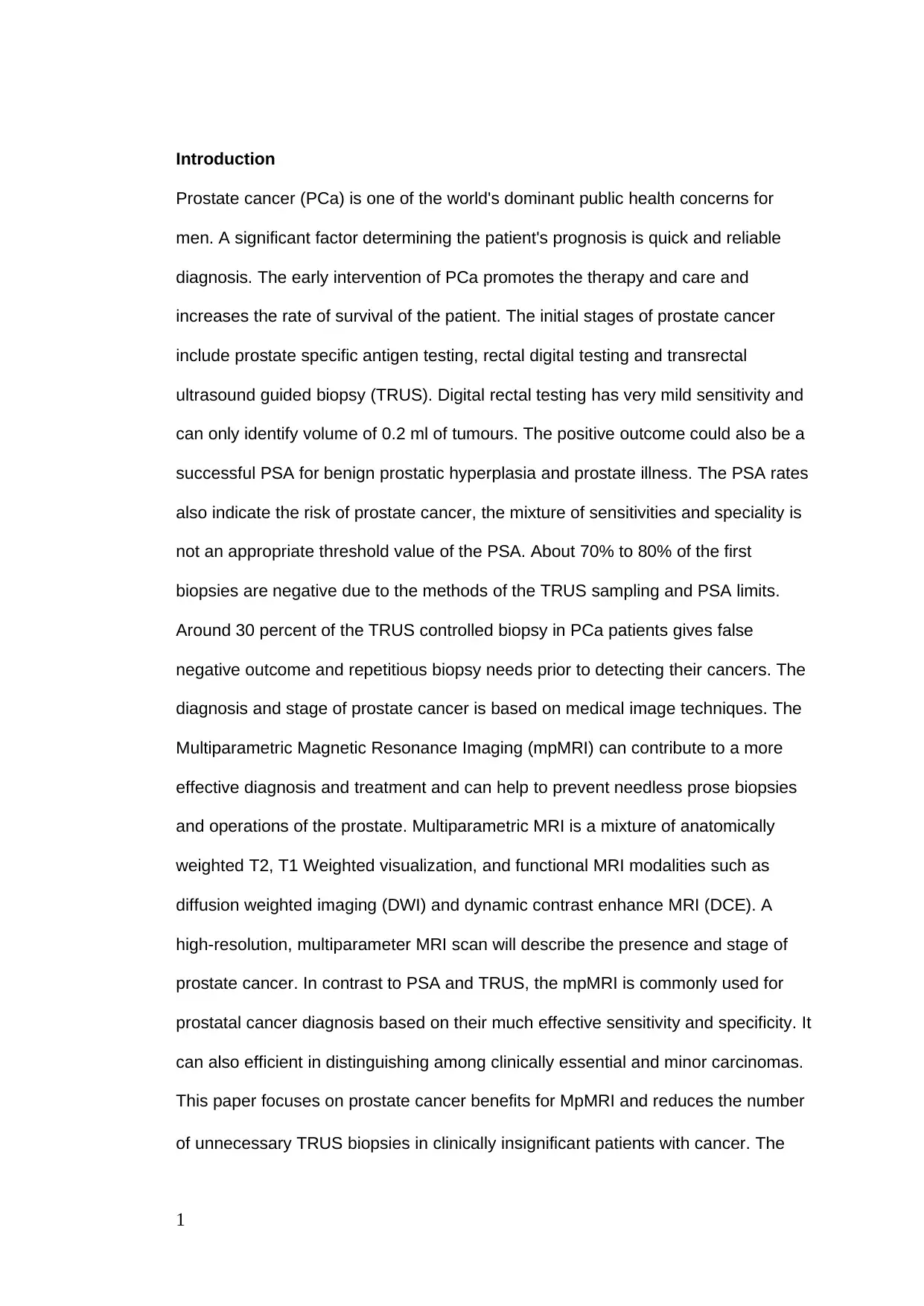
Introduction
Prostate cancer (PCa) is one of the world's dominant public health concerns for
men. A significant factor determining the patient's prognosis is quick and reliable
diagnosis. The early intervention of PCa promotes the therapy and care and
increases the rate of survival of the patient. The initial stages of prostate cancer
include prostate specific antigen testing, rectal digital testing and transrectal
ultrasound guided biopsy (TRUS). Digital rectal testing has very mild sensitivity and
can only identify volume of 0.2 ml of tumours. The positive outcome could also be a
successful PSA for benign prostatic hyperplasia and prostate illness. The PSA rates
also indicate the risk of prostate cancer, the mixture of sensitivities and speciality is
not an appropriate threshold value of the PSA. About 70% to 80% of the first
biopsies are negative due to the methods of the TRUS sampling and PSA limits.
Around 30 percent of the TRUS controlled biopsy in PCa patients gives false
negative outcome and repetitious biopsy needs prior to detecting their cancers. The
diagnosis and stage of prostate cancer is based on medical image techniques. The
Multiparametric Magnetic Resonance Imaging (mpMRI) can contribute to a more
effective diagnosis and treatment and can help to prevent needless prose biopsies
and operations of the prostate. Multiparametric MRI is a mixture of anatomically
weighted T2, T1 Weighted visualization, and functional MRI modalities such as
diffusion weighted imaging (DWI) and dynamic contrast enhance MRI (DCE). A
high-resolution, multiparameter MRI scan will describe the presence and stage of
prostate cancer. In contrast to PSA and TRUS, the mpMRI is commonly used for
prostatal cancer diagnosis based on their much effective sensitivity and specificity. It
can also efficient in distinguishing among clinically essential and minor carcinomas.
This paper focuses on prostate cancer benefits for MpMRI and reduces the number
of unnecessary TRUS biopsies in clinically insignificant patients with cancer. The
1
Prostate cancer (PCa) is one of the world's dominant public health concerns for
men. A significant factor determining the patient's prognosis is quick and reliable
diagnosis. The early intervention of PCa promotes the therapy and care and
increases the rate of survival of the patient. The initial stages of prostate cancer
include prostate specific antigen testing, rectal digital testing and transrectal
ultrasound guided biopsy (TRUS). Digital rectal testing has very mild sensitivity and
can only identify volume of 0.2 ml of tumours. The positive outcome could also be a
successful PSA for benign prostatic hyperplasia and prostate illness. The PSA rates
also indicate the risk of prostate cancer, the mixture of sensitivities and speciality is
not an appropriate threshold value of the PSA. About 70% to 80% of the first
biopsies are negative due to the methods of the TRUS sampling and PSA limits.
Around 30 percent of the TRUS controlled biopsy in PCa patients gives false
negative outcome and repetitious biopsy needs prior to detecting their cancers. The
diagnosis and stage of prostate cancer is based on medical image techniques. The
Multiparametric Magnetic Resonance Imaging (mpMRI) can contribute to a more
effective diagnosis and treatment and can help to prevent needless prose biopsies
and operations of the prostate. Multiparametric MRI is a mixture of anatomically
weighted T2, T1 Weighted visualization, and functional MRI modalities such as
diffusion weighted imaging (DWI) and dynamic contrast enhance MRI (DCE). A
high-resolution, multiparameter MRI scan will describe the presence and stage of
prostate cancer. In contrast to PSA and TRUS, the mpMRI is commonly used for
prostatal cancer diagnosis based on their much effective sensitivity and specificity. It
can also efficient in distinguishing among clinically essential and minor carcinomas.
This paper focuses on prostate cancer benefits for MpMRI and reduces the number
of unnecessary TRUS biopsies in clinically insignificant patients with cancer. The
1
Secure Best Marks with AI Grader
Need help grading? Try our AI Grader for instant feedback on your assignments.
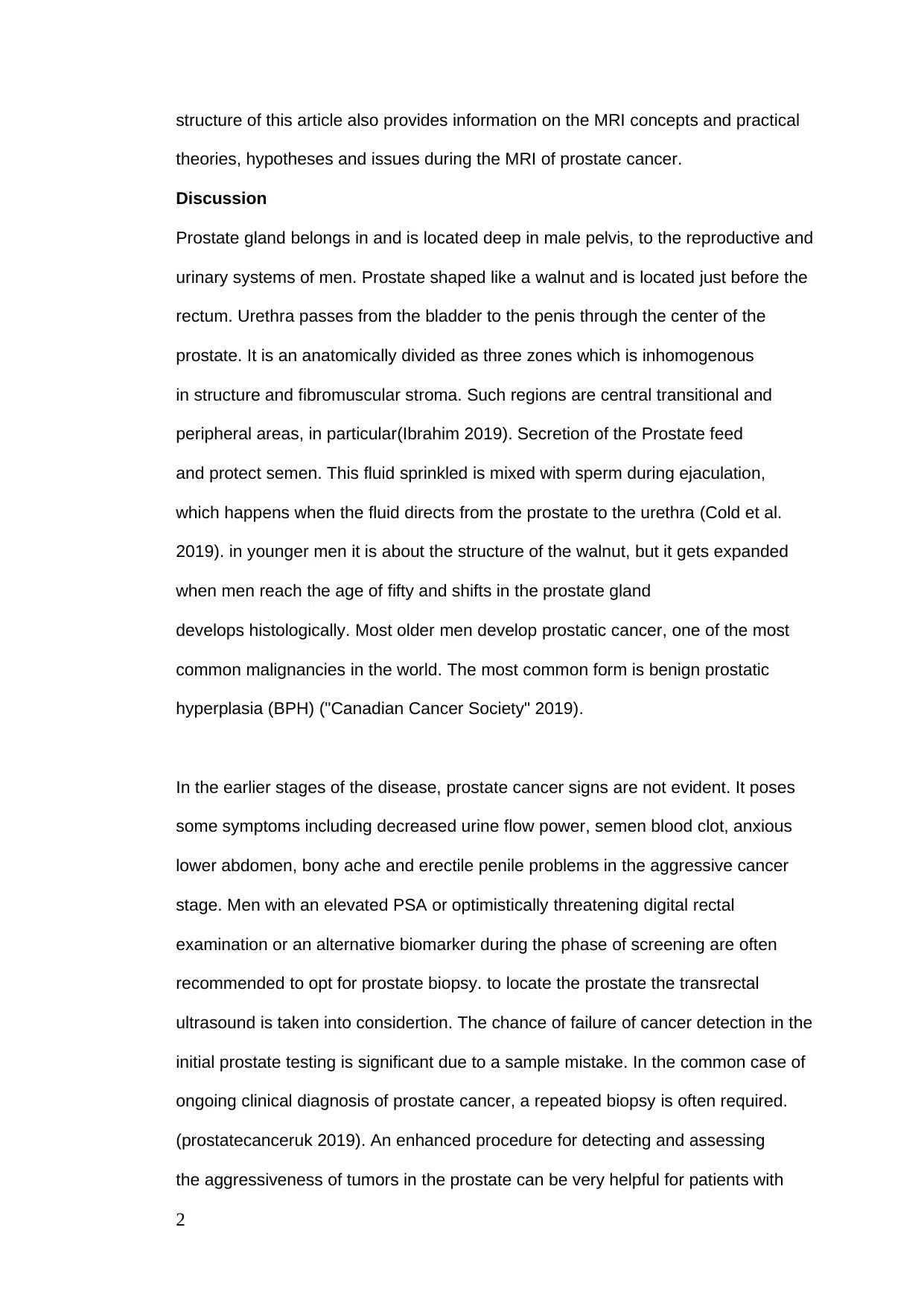
structure of this article also provides information on the MRI concepts and practical
theories, hypotheses and issues during the MRI of prostate cancer.
Discussion
Prostate gland belongs in and is located deep in male pelvis, to the reproductive and
urinary systems of men. Prostate shaped like a walnut and is located just before the
rectum. Urethra passes from the bladder to the penis through the center of the
prostate. It is an anatomically divided as three zones which is inhomogenous
in structure and fibromuscular stroma. Such regions are central transitional and
peripheral areas, in particular(Ibrahim 2019). Secretion of the Prostate feed
and protect semen. This fluid sprinkled is mixed with sperm during ejaculation,
which happens when the fluid directs from the prostate to the urethra (Cold et al.
2019). in younger men it is about the structure of the walnut, but it gets expanded
when men reach the age of fifty and shifts in the prostate gland
develops histologically. Most older men develop prostatic cancer, one of the most
common malignancies in the world. The most common form is benign prostatic
hyperplasia (BPH) ("Canadian Cancer Society" 2019).
In the earlier stages of the disease, prostate cancer signs are not evident. It poses
some symptoms including decreased urine flow power, semen blood clot, anxious
lower abdomen, bony ache and erectile penile problems in the aggressive cancer
stage. Men with an elevated PSA or optimistically threatening digital rectal
examination or an alternative biomarker during the phase of screening are often
recommended to opt for prostate biopsy. to locate the prostate the transrectal
ultrasound is taken into considertion. The chance of failure of cancer detection in the
initial prostate testing is significant due to a sample mistake. In the common case of
ongoing clinical diagnosis of prostate cancer, a repeated biopsy is often required.
(prostatecanceruk 2019). An enhanced procedure for detecting and assessing
the aggressiveness of tumors in the prostate can be very helpful for patients with
2
theories, hypotheses and issues during the MRI of prostate cancer.
Discussion
Prostate gland belongs in and is located deep in male pelvis, to the reproductive and
urinary systems of men. Prostate shaped like a walnut and is located just before the
rectum. Urethra passes from the bladder to the penis through the center of the
prostate. It is an anatomically divided as three zones which is inhomogenous
in structure and fibromuscular stroma. Such regions are central transitional and
peripheral areas, in particular(Ibrahim 2019). Secretion of the Prostate feed
and protect semen. This fluid sprinkled is mixed with sperm during ejaculation,
which happens when the fluid directs from the prostate to the urethra (Cold et al.
2019). in younger men it is about the structure of the walnut, but it gets expanded
when men reach the age of fifty and shifts in the prostate gland
develops histologically. Most older men develop prostatic cancer, one of the most
common malignancies in the world. The most common form is benign prostatic
hyperplasia (BPH) ("Canadian Cancer Society" 2019).
In the earlier stages of the disease, prostate cancer signs are not evident. It poses
some symptoms including decreased urine flow power, semen blood clot, anxious
lower abdomen, bony ache and erectile penile problems in the aggressive cancer
stage. Men with an elevated PSA or optimistically threatening digital rectal
examination or an alternative biomarker during the phase of screening are often
recommended to opt for prostate biopsy. to locate the prostate the transrectal
ultrasound is taken into considertion. The chance of failure of cancer detection in the
initial prostate testing is significant due to a sample mistake. In the common case of
ongoing clinical diagnosis of prostate cancer, a repeated biopsy is often required.
(prostatecanceruk 2019). An enhanced procedure for detecting and assessing
the aggressiveness of tumors in the prostate can be very helpful for patients with
2
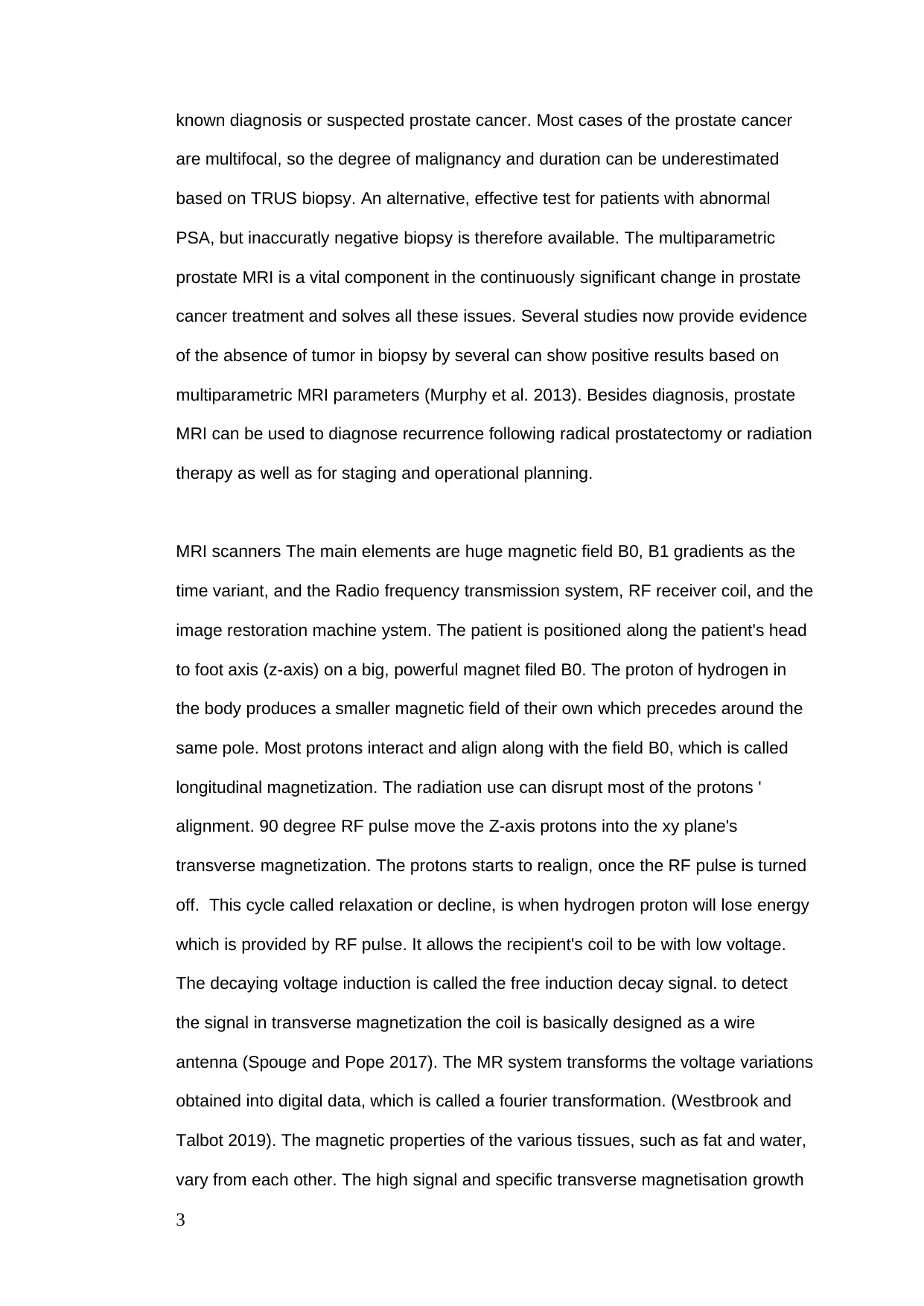
known diagnosis or suspected prostate cancer. Most cases of the prostate cancer
are multifocal, so the degree of malignancy and duration can be underestimated
based on TRUS biopsy. An alternative, effective test for patients with abnormal
PSA, but inaccuratly negative biopsy is therefore available. The multiparametric
prostate MRI is a vital component in the continuously significant change in prostate
cancer treatment and solves all these issues. Several studies now provide evidence
of the absence of tumor in biopsy by several can show positive results based on
multiparametric MRI parameters (Murphy et al. 2013). Besides diagnosis, prostate
MRI can be used to diagnose recurrence following radical prostatectomy or radiation
therapy as well as for staging and operational planning.
MRI scanners The main elements are huge magnetic field B0, B1 gradients as the
time variant, and the Radio frequency transmission system, RF receiver coil, and the
image restoration machine ystem. The patient is positioned along the patient's head
to foot axis (z-axis) on a big, powerful magnet filed B0. The proton of hydrogen in
the body produces a smaller magnetic field of their own which precedes around the
same pole. Most protons interact and align along with the field B0, which is called
longitudinal magnetization. The radiation use can disrupt most of the protons '
alignment. 90 degree RF pulse move the Z-axis protons into the xy plane's
transverse magnetization. The protons starts to realign, once the RF pulse is turned
off. This cycle called relaxation or decline, is when hydrogen proton will lose energy
which is provided by RF pulse. It allows the recipient's coil to be with low voltage.
The decaying voltage induction is called the free induction decay signal. to detect
the signal in transverse magnetization the coil is basically designed as a wire
antenna (Spouge and Pope 2017). The MR system transforms the voltage variations
obtained into digital data, which is called a fourier transformation. (Westbrook and
Talbot 2019). The magnetic properties of the various tissues, such as fat and water,
vary from each other. The high signal and specific transverse magnetisation growth
3
are multifocal, so the degree of malignancy and duration can be underestimated
based on TRUS biopsy. An alternative, effective test for patients with abnormal
PSA, but inaccuratly negative biopsy is therefore available. The multiparametric
prostate MRI is a vital component in the continuously significant change in prostate
cancer treatment and solves all these issues. Several studies now provide evidence
of the absence of tumor in biopsy by several can show positive results based on
multiparametric MRI parameters (Murphy et al. 2013). Besides diagnosis, prostate
MRI can be used to diagnose recurrence following radical prostatectomy or radiation
therapy as well as for staging and operational planning.
MRI scanners The main elements are huge magnetic field B0, B1 gradients as the
time variant, and the Radio frequency transmission system, RF receiver coil, and the
image restoration machine ystem. The patient is positioned along the patient's head
to foot axis (z-axis) on a big, powerful magnet filed B0. The proton of hydrogen in
the body produces a smaller magnetic field of their own which precedes around the
same pole. Most protons interact and align along with the field B0, which is called
longitudinal magnetization. The radiation use can disrupt most of the protons '
alignment. 90 degree RF pulse move the Z-axis protons into the xy plane's
transverse magnetization. The protons starts to realign, once the RF pulse is turned
off. This cycle called relaxation or decline, is when hydrogen proton will lose energy
which is provided by RF pulse. It allows the recipient's coil to be with low voltage.
The decaying voltage induction is called the free induction decay signal. to detect
the signal in transverse magnetization the coil is basically designed as a wire
antenna (Spouge and Pope 2017). The MR system transforms the voltage variations
obtained into digital data, which is called a fourier transformation. (Westbrook and
Talbot 2019). The magnetic properties of the various tissues, such as fat and water,
vary from each other. The high signal and specific transverse magnetisation growth
3
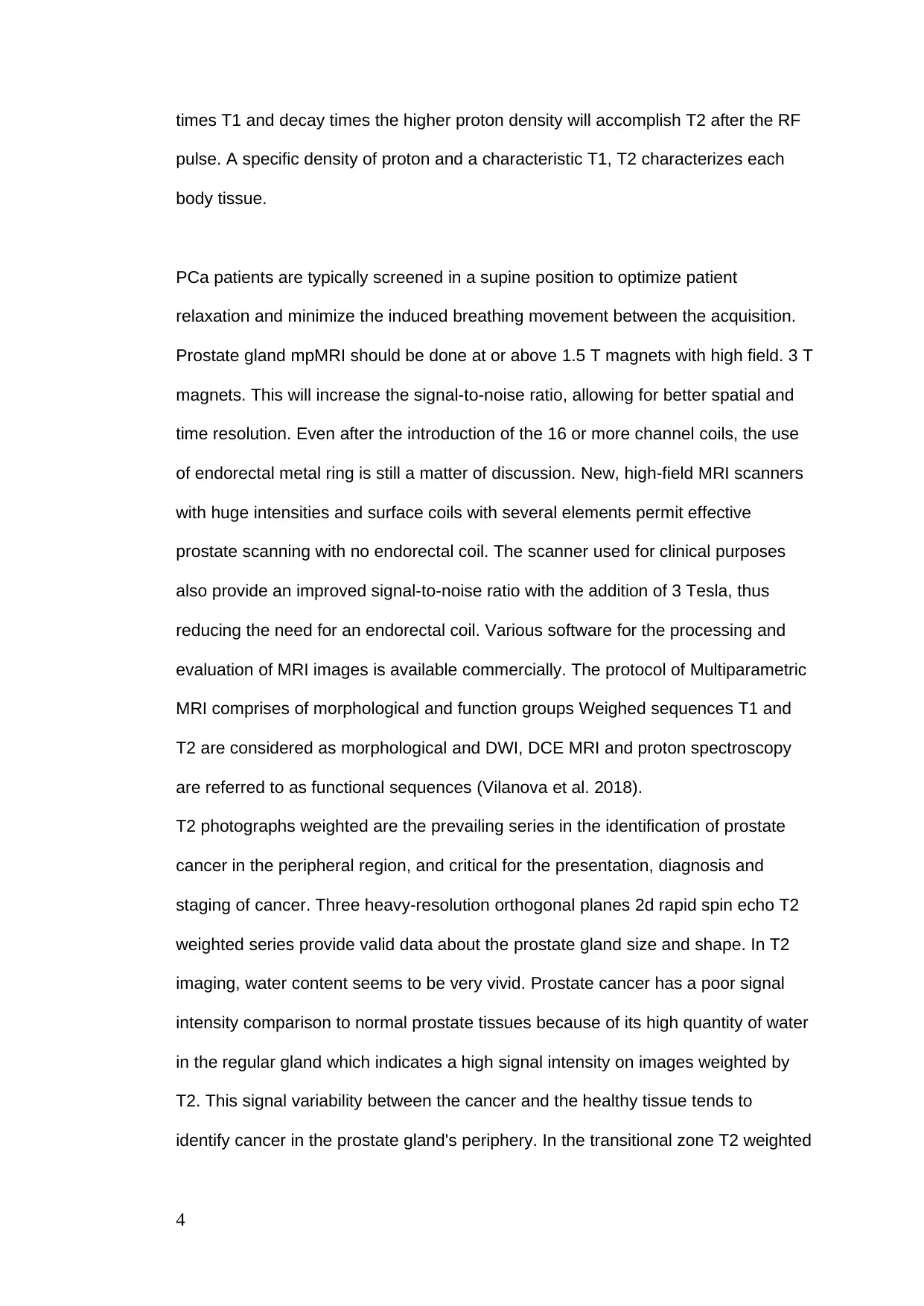
times T1 and decay times the higher proton density will accomplish T2 after the RF
pulse. A specific density of proton and a characteristic T1, T2 characterizes each
body tissue.
PCa patients are typically screened in a supine position to optimize patient
relaxation and minimize the induced breathing movement between the acquisition.
Prostate gland mpMRI should be done at or above 1.5 T magnets with high field. 3 T
magnets. This will increase the signal-to-noise ratio, allowing for better spatial and
time resolution. Even after the introduction of the 16 or more channel coils, the use
of endorectal metal ring is still a matter of discussion. New, high-field MRI scanners
with huge intensities and surface coils with several elements permit effective
prostate scanning with no endorectal coil. The scanner used for clinical purposes
also provide an improved signal-to-noise ratio with the addition of 3 Tesla, thus
reducing the need for an endorectal coil. Various software for the processing and
evaluation of MRI images is available commercially. The protocol of Multiparametric
MRI comprises of morphological and function groups Weighed sequences T1 and
T2 are considered as morphological and DWI, DCE MRI and proton spectroscopy
are referred to as functional sequences (Vilanova et al. 2018).
T2 photographs weighted are the prevailing series in the identification of prostate
cancer in the peripheral region, and critical for the presentation, diagnosis and
staging of cancer. Three heavy-resolution orthogonal planes 2d rapid spin echo T2
weighted series provide valid data about the prostate gland size and shape. In T2
imaging, water content seems to be very vivid. Prostate cancer has a poor signal
intensity comparison to normal prostate tissues because of its high quantity of water
in the regular gland which indicates a high signal intensity on images weighted by
T2. This signal variability between the cancer and the healthy tissue tends to
identify cancer in the prostate gland's periphery. In the transitional zone T2 weighted
4
pulse. A specific density of proton and a characteristic T1, T2 characterizes each
body tissue.
PCa patients are typically screened in a supine position to optimize patient
relaxation and minimize the induced breathing movement between the acquisition.
Prostate gland mpMRI should be done at or above 1.5 T magnets with high field. 3 T
magnets. This will increase the signal-to-noise ratio, allowing for better spatial and
time resolution. Even after the introduction of the 16 or more channel coils, the use
of endorectal metal ring is still a matter of discussion. New, high-field MRI scanners
with huge intensities and surface coils with several elements permit effective
prostate scanning with no endorectal coil. The scanner used for clinical purposes
also provide an improved signal-to-noise ratio with the addition of 3 Tesla, thus
reducing the need for an endorectal coil. Various software for the processing and
evaluation of MRI images is available commercially. The protocol of Multiparametric
MRI comprises of morphological and function groups Weighed sequences T1 and
T2 are considered as morphological and DWI, DCE MRI and proton spectroscopy
are referred to as functional sequences (Vilanova et al. 2018).
T2 photographs weighted are the prevailing series in the identification of prostate
cancer in the peripheral region, and critical for the presentation, diagnosis and
staging of cancer. Three heavy-resolution orthogonal planes 2d rapid spin echo T2
weighted series provide valid data about the prostate gland size and shape. In T2
imaging, water content seems to be very vivid. Prostate cancer has a poor signal
intensity comparison to normal prostate tissues because of its high quantity of water
in the regular gland which indicates a high signal intensity on images weighted by
T2. This signal variability between the cancer and the healthy tissue tends to
identify cancer in the prostate gland's periphery. In the transitional zone T2 weighted
4
Secure Best Marks with AI Grader
Need help grading? Try our AI Grader for instant feedback on your assignments.
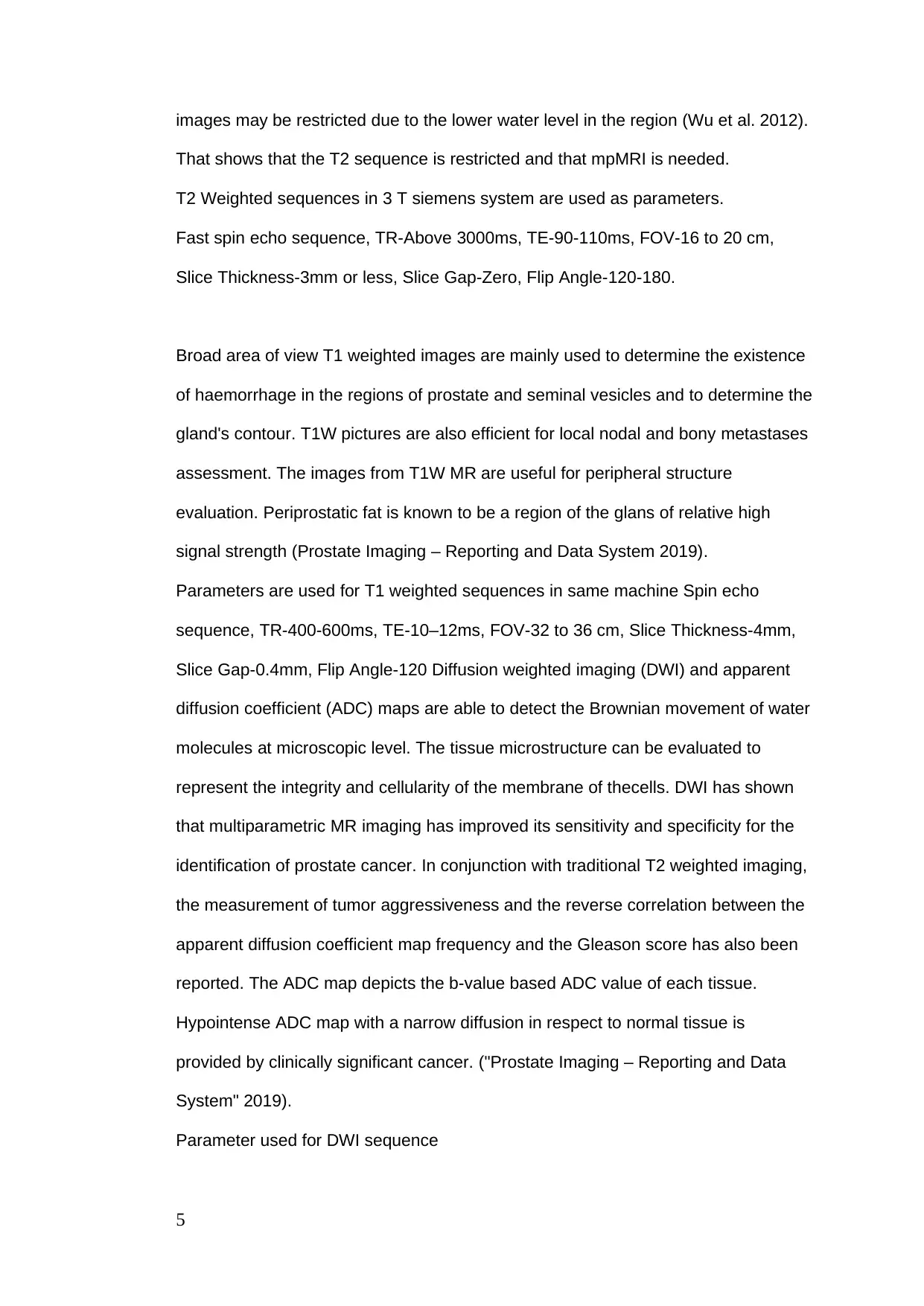
images may be restricted due to the lower water level in the region (Wu et al. 2012).
That shows that the T2 sequence is restricted and that mpMRI is needed.
T2 Weighted sequences in 3 T siemens system are used as parameters.
Fast spin echo sequence, TR-Above 3000ms, TE-90-110ms, FOV-16 to 20 cm,
Slice Thickness-3mm or less, Slice Gap-Zero, Flip Angle-120-180.
Broad area of view T1 weighted images are mainly used to determine the existence
of haemorrhage in the regions of prostate and seminal vesicles and to determine the
gland's contour. T1W pictures are also efficient for local nodal and bony metastases
assessment. The images from T1W MR are useful for peripheral structure
evaluation. Periprostatic fat is known to be a region of the glans of relative high
signal strength (Prostate Imaging – Reporting and Data System 2019).
Parameters are used for T1 weighted sequences in same machine Spin echo
sequence, TR-400-600ms, TE-10–12ms, FOV-32 to 36 cm, Slice Thickness-4mm,
Slice Gap-0.4mm, Flip Angle-120 Diffusion weighted imaging (DWI) and apparent
diffusion coefficient (ADC) maps are able to detect the Brownian movement of water
molecules at microscopic level. The tissue microstructure can be evaluated to
represent the integrity and cellularity of the membrane of thecells. DWI has shown
that multiparametric MR imaging has improved its sensitivity and specificity for the
identification of prostate cancer. In conjunction with traditional T2 weighted imaging,
the measurement of tumor aggressiveness and the reverse correlation between the
apparent diffusion coefficient map frequency and the Gleason score has also been
reported. The ADC map depicts the b-value based ADC value of each tissue.
Hypointense ADC map with a narrow diffusion in respect to normal tissue is
provided by clinically significant cancer. ("Prostate Imaging – Reporting and Data
System" 2019).
Parameter used for DWI sequence
5
That shows that the T2 sequence is restricted and that mpMRI is needed.
T2 Weighted sequences in 3 T siemens system are used as parameters.
Fast spin echo sequence, TR-Above 3000ms, TE-90-110ms, FOV-16 to 20 cm,
Slice Thickness-3mm or less, Slice Gap-Zero, Flip Angle-120-180.
Broad area of view T1 weighted images are mainly used to determine the existence
of haemorrhage in the regions of prostate and seminal vesicles and to determine the
gland's contour. T1W pictures are also efficient for local nodal and bony metastases
assessment. The images from T1W MR are useful for peripheral structure
evaluation. Periprostatic fat is known to be a region of the glans of relative high
signal strength (Prostate Imaging – Reporting and Data System 2019).
Parameters are used for T1 weighted sequences in same machine Spin echo
sequence, TR-400-600ms, TE-10–12ms, FOV-32 to 36 cm, Slice Thickness-4mm,
Slice Gap-0.4mm, Flip Angle-120 Diffusion weighted imaging (DWI) and apparent
diffusion coefficient (ADC) maps are able to detect the Brownian movement of water
molecules at microscopic level. The tissue microstructure can be evaluated to
represent the integrity and cellularity of the membrane of thecells. DWI has shown
that multiparametric MR imaging has improved its sensitivity and specificity for the
identification of prostate cancer. In conjunction with traditional T2 weighted imaging,
the measurement of tumor aggressiveness and the reverse correlation between the
apparent diffusion coefficient map frequency and the Gleason score has also been
reported. The ADC map depicts the b-value based ADC value of each tissue.
Hypointense ADC map with a narrow diffusion in respect to normal tissue is
provided by clinically significant cancer. ("Prostate Imaging – Reporting and Data
System" 2019).
Parameter used for DWI sequence
5
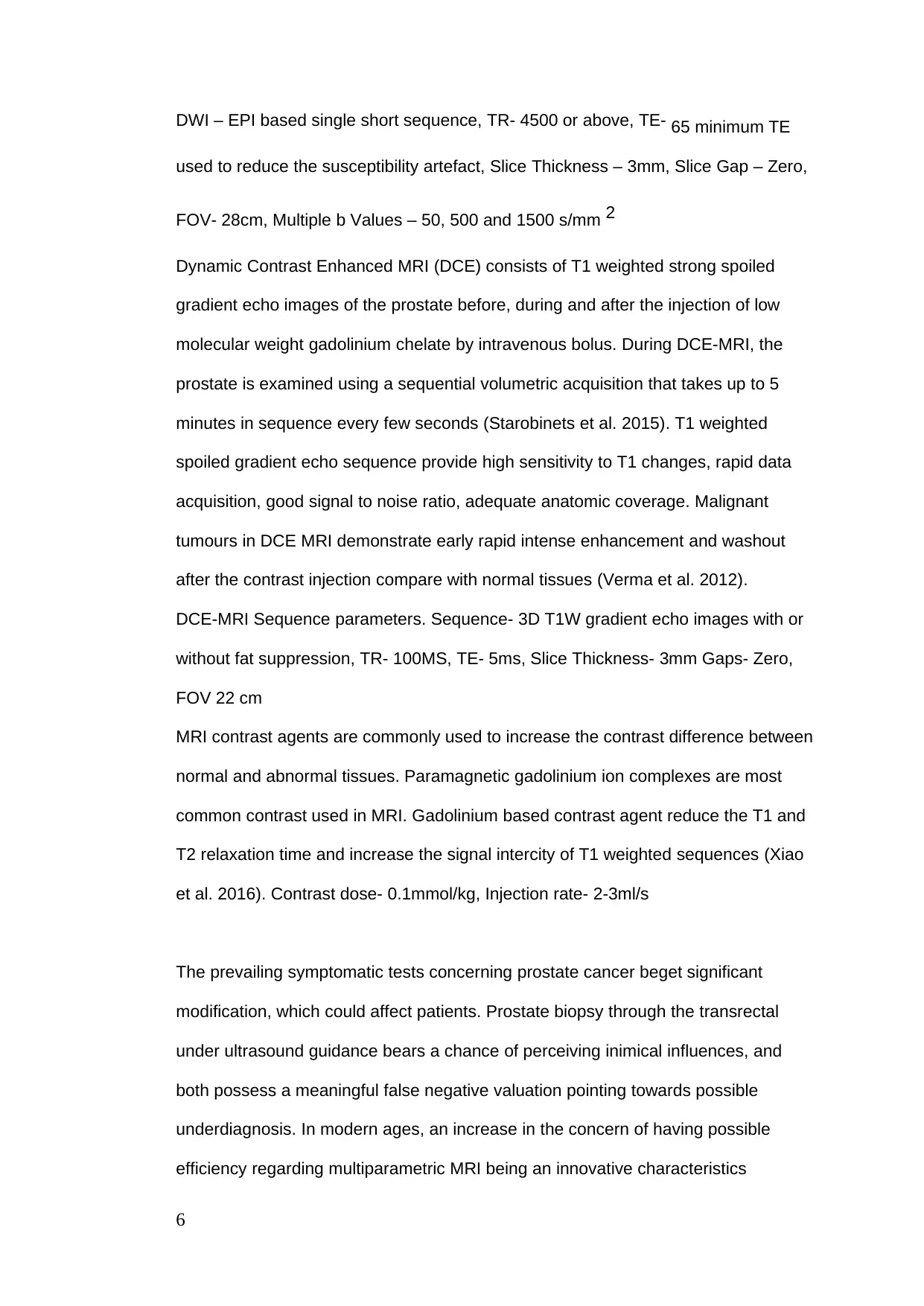
DWI – EPI based single short sequence, TR- 4500 or above, TE- 65 minimum TE
used to reduce the susceptibility artefact, Slice Thickness – 3mm, Slice Gap – Zero,
FOV- 28cm, Multiple b Values – 50, 500 and 1500 s/mm 2
Dynamic Contrast Enhanced MRI (DCE) consists of T1 weighted strong spoiled
gradient echo images of the prostate before, during and after the injection of low
molecular weight gadolinium chelate by intravenous bolus. During DCE-MRI, the
prostate is examined using a sequential volumetric acquisition that takes up to 5
minutes in sequence every few seconds (Starobinets et al. 2015). T1 weighted
spoiled gradient echo sequence provide high sensitivity to T1 changes, rapid data
acquisition, good signal to noise ratio, adequate anatomic coverage. Malignant
tumours in DCE MRI demonstrate early rapid intense enhancement and washout
after the contrast injection compare with normal tissues (Verma et al. 2012).
DCE-MRI Sequence parameters. Sequence- 3D T1W gradient echo images with or
without fat suppression, TR- 100MS, TE- 5ms, Slice Thickness- 3mm Gaps- Zero,
FOV 22 cm
MRI contrast agents are commonly used to increase the contrast difference between
normal and abnormal tissues. Paramagnetic gadolinium ion complexes are most
common contrast used in MRI. Gadolinium based contrast agent reduce the T1 and
T2 relaxation time and increase the signal intercity of T1 weighted sequences (Xiao
et al. 2016). Contrast dose- 0.1mmol/kg, Injection rate- 2-3ml/s
The prevailing symptomatic tests concerning prostate cancer beget significant
modification, which could affect patients. Prostate biopsy through the transrectal
under ultrasound guidance bears a chance of perceiving inimical influences, and
both possess a meaningful false negative valuation pointing towards possible
underdiagnosis. In modern ages, an increase in the concern of having possible
efficiency regarding multiparametric MRI being an innovative characteristics
6
used to reduce the susceptibility artefact, Slice Thickness – 3mm, Slice Gap – Zero,
FOV- 28cm, Multiple b Values – 50, 500 and 1500 s/mm 2
Dynamic Contrast Enhanced MRI (DCE) consists of T1 weighted strong spoiled
gradient echo images of the prostate before, during and after the injection of low
molecular weight gadolinium chelate by intravenous bolus. During DCE-MRI, the
prostate is examined using a sequential volumetric acquisition that takes up to 5
minutes in sequence every few seconds (Starobinets et al. 2015). T1 weighted
spoiled gradient echo sequence provide high sensitivity to T1 changes, rapid data
acquisition, good signal to noise ratio, adequate anatomic coverage. Malignant
tumours in DCE MRI demonstrate early rapid intense enhancement and washout
after the contrast injection compare with normal tissues (Verma et al. 2012).
DCE-MRI Sequence parameters. Sequence- 3D T1W gradient echo images with or
without fat suppression, TR- 100MS, TE- 5ms, Slice Thickness- 3mm Gaps- Zero,
FOV 22 cm
MRI contrast agents are commonly used to increase the contrast difference between
normal and abnormal tissues. Paramagnetic gadolinium ion complexes are most
common contrast used in MRI. Gadolinium based contrast agent reduce the T1 and
T2 relaxation time and increase the signal intercity of T1 weighted sequences (Xiao
et al. 2016). Contrast dose- 0.1mmol/kg, Injection rate- 2-3ml/s
The prevailing symptomatic tests concerning prostate cancer beget significant
modification, which could affect patients. Prostate biopsy through the transrectal
under ultrasound guidance bears a chance of perceiving inimical influences, and
both possess a meaningful false negative valuation pointing towards possible
underdiagnosis. In modern ages, an increase in the concern of having possible
efficiency regarding multiparametric MRI being an innovative characteristics
6
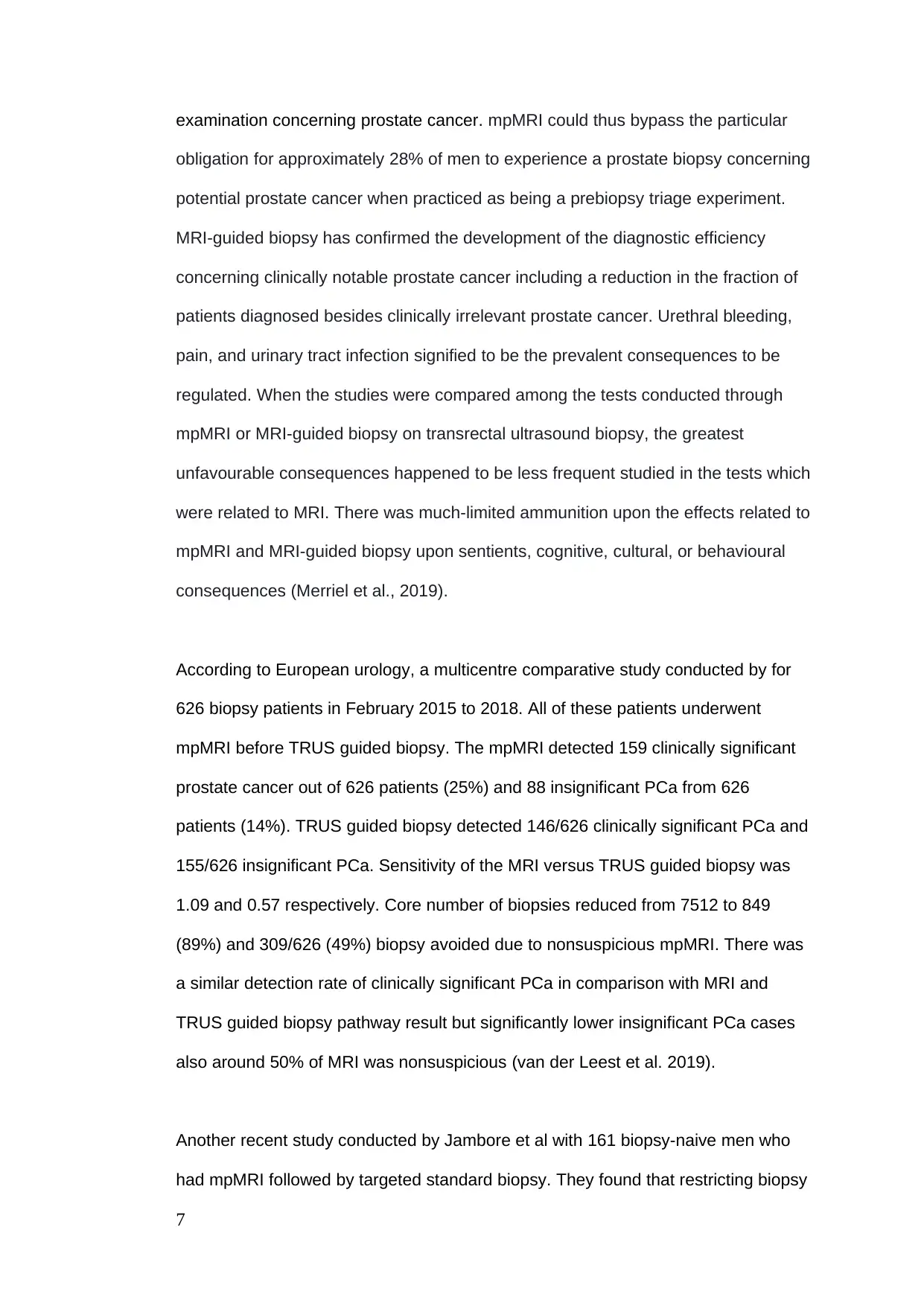
examination concerning prostate cancer. mpMRI could thus bypass the particular
obligation for approximately 28% of men to experience a prostate biopsy concerning
potential prostate cancer when practiced as being a prebiopsy triage experiment.
MRI-guided biopsy has confirmed the development of the diagnostic efficiency
concerning clinically notable prostate cancer including a reduction in the fraction of
patients diagnosed besides clinically irrelevant prostate cancer. Urethral bleeding,
pain, and urinary tract infection signified to be the prevalent consequences to be
regulated. When the studies were compared among the tests conducted through
mpMRI or MRI-guided biopsy on transrectal ultrasound biopsy, the greatest
unfavourable consequences happened to be less frequent studied in the tests which
were related to MRI. There was much-limited ammunition upon the effects related to
mpMRI and MRI-guided biopsy upon sentients, cognitive, cultural, or behavioural
consequences (Merriel et al., 2019).
According to European urology, a multicentre comparative study conducted by for
626 biopsy patients in February 2015 to 2018. All of these patients underwent
mpMRI before TRUS guided biopsy. The mpMRI detected 159 clinically significant
prostate cancer out of 626 patients (25%) and 88 insignificant PCa from 626
patients (14%). TRUS guided biopsy detected 146/626 clinically significant PCa and
155/626 insignificant PCa. Sensitivity of the MRI versus TRUS guided biopsy was
1.09 and 0.57 respectively. Core number of biopsies reduced from 7512 to 849
(89%) and 309/626 (49%) biopsy avoided due to nonsuspicious mpMRI. There was
a similar detection rate of clinically significant PCa in comparison with MRI and
TRUS guided biopsy pathway result but significantly lower insignificant PCa cases
also around 50% of MRI was nonsuspicious (van der Leest et al. 2019).
Another recent study conducted by Jambore et al with 161 biopsy-naive men who
had mpMRI followed by targeted standard biopsy. They found that restricting biopsy
7
obligation for approximately 28% of men to experience a prostate biopsy concerning
potential prostate cancer when practiced as being a prebiopsy triage experiment.
MRI-guided biopsy has confirmed the development of the diagnostic efficiency
concerning clinically notable prostate cancer including a reduction in the fraction of
patients diagnosed besides clinically irrelevant prostate cancer. Urethral bleeding,
pain, and urinary tract infection signified to be the prevalent consequences to be
regulated. When the studies were compared among the tests conducted through
mpMRI or MRI-guided biopsy on transrectal ultrasound biopsy, the greatest
unfavourable consequences happened to be less frequent studied in the tests which
were related to MRI. There was much-limited ammunition upon the effects related to
mpMRI and MRI-guided biopsy upon sentients, cognitive, cultural, or behavioural
consequences (Merriel et al., 2019).
According to European urology, a multicentre comparative study conducted by for
626 biopsy patients in February 2015 to 2018. All of these patients underwent
mpMRI before TRUS guided biopsy. The mpMRI detected 159 clinically significant
prostate cancer out of 626 patients (25%) and 88 insignificant PCa from 626
patients (14%). TRUS guided biopsy detected 146/626 clinically significant PCa and
155/626 insignificant PCa. Sensitivity of the MRI versus TRUS guided biopsy was
1.09 and 0.57 respectively. Core number of biopsies reduced from 7512 to 849
(89%) and 309/626 (49%) biopsy avoided due to nonsuspicious mpMRI. There was
a similar detection rate of clinically significant PCa in comparison with MRI and
TRUS guided biopsy pathway result but significantly lower insignificant PCa cases
also around 50% of MRI was nonsuspicious (van der Leest et al. 2019).
Another recent study conducted by Jambore et al with 161 biopsy-naive men who
had mpMRI followed by targeted standard biopsy. They found that restricting biopsy
7
Paraphrase This Document
Need a fresh take? Get an instant paraphrase of this document with our AI Paraphraser
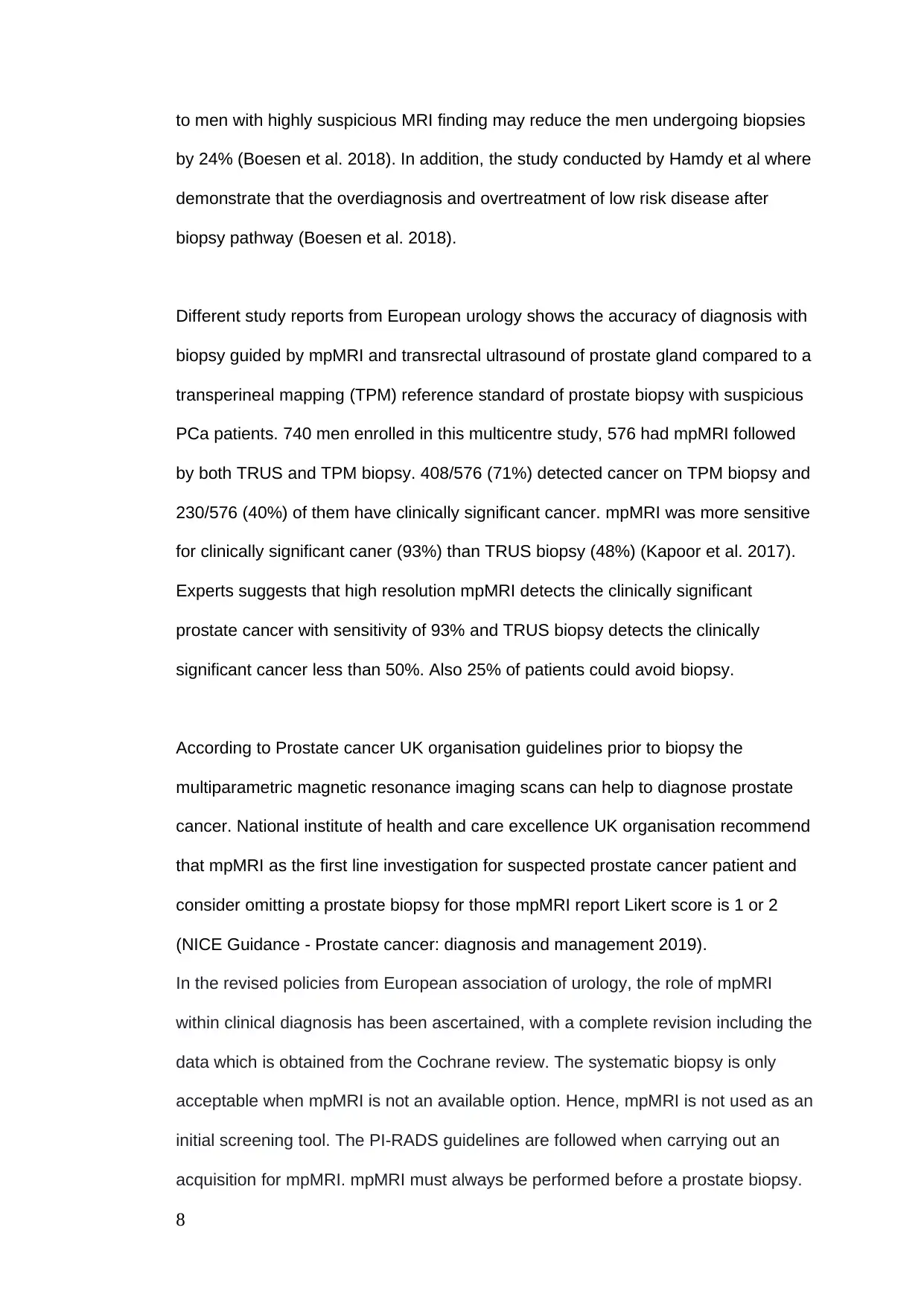
to men with highly suspicious MRI finding may reduce the men undergoing biopsies
by 24% (Boesen et al. 2018). In addition, the study conducted by Hamdy et al where
demonstrate that the overdiagnosis and overtreatment of low risk disease after
biopsy pathway (Boesen et al. 2018).
Different study reports from European urology shows the accuracy of diagnosis with
biopsy guided by mpMRI and transrectal ultrasound of prostate gland compared to a
transperineal mapping (TPM) reference standard of prostate biopsy with suspicious
PCa patients. 740 men enrolled in this multicentre study, 576 had mpMRI followed
by both TRUS and TPM biopsy. 408/576 (71%) detected cancer on TPM biopsy and
230/576 (40%) of them have clinically significant cancer. mpMRI was more sensitive
for clinically significant caner (93%) than TRUS biopsy (48%) (Kapoor et al. 2017).
Experts suggests that high resolution mpMRI detects the clinically significant
prostate cancer with sensitivity of 93% and TRUS biopsy detects the clinically
significant cancer less than 50%. Also 25% of patients could avoid biopsy.
According to Prostate cancer UK organisation guidelines prior to biopsy the
multiparametric magnetic resonance imaging scans can help to diagnose prostate
cancer. National institute of health and care excellence UK organisation recommend
that mpMRI as the first line investigation for suspected prostate cancer patient and
consider omitting a prostate biopsy for those mpMRI report Likert score is 1 or 2
(NICE Guidance - Prostate cancer: diagnosis and management 2019).
In the revised policies from European association of urology, the role of mpMRI
within clinical diagnosis has been ascertained, with a complete revision including the
data which is obtained from the Cochrane review. The systematic biopsy is only
acceptable when mpMRI is not an available option. Hence, mpMRI is not used as an
initial screening tool. The PI-RADS guidelines are followed when carrying out an
acquisition for mpMRI. mpMRI must always be performed before a prostate biopsy.
8
by 24% (Boesen et al. 2018). In addition, the study conducted by Hamdy et al where
demonstrate that the overdiagnosis and overtreatment of low risk disease after
biopsy pathway (Boesen et al. 2018).
Different study reports from European urology shows the accuracy of diagnosis with
biopsy guided by mpMRI and transrectal ultrasound of prostate gland compared to a
transperineal mapping (TPM) reference standard of prostate biopsy with suspicious
PCa patients. 740 men enrolled in this multicentre study, 576 had mpMRI followed
by both TRUS and TPM biopsy. 408/576 (71%) detected cancer on TPM biopsy and
230/576 (40%) of them have clinically significant cancer. mpMRI was more sensitive
for clinically significant caner (93%) than TRUS biopsy (48%) (Kapoor et al. 2017).
Experts suggests that high resolution mpMRI detects the clinically significant
prostate cancer with sensitivity of 93% and TRUS biopsy detects the clinically
significant cancer less than 50%. Also 25% of patients could avoid biopsy.
According to Prostate cancer UK organisation guidelines prior to biopsy the
multiparametric magnetic resonance imaging scans can help to diagnose prostate
cancer. National institute of health and care excellence UK organisation recommend
that mpMRI as the first line investigation for suspected prostate cancer patient and
consider omitting a prostate biopsy for those mpMRI report Likert score is 1 or 2
(NICE Guidance - Prostate cancer: diagnosis and management 2019).
In the revised policies from European association of urology, the role of mpMRI
within clinical diagnosis has been ascertained, with a complete revision including the
data which is obtained from the Cochrane review. The systematic biopsy is only
acceptable when mpMRI is not an available option. Hence, mpMRI is not used as an
initial screening tool. The PI-RADS guidelines are followed when carrying out an
acquisition for mpMRI. mpMRI must always be performed before a prostate biopsy.
8
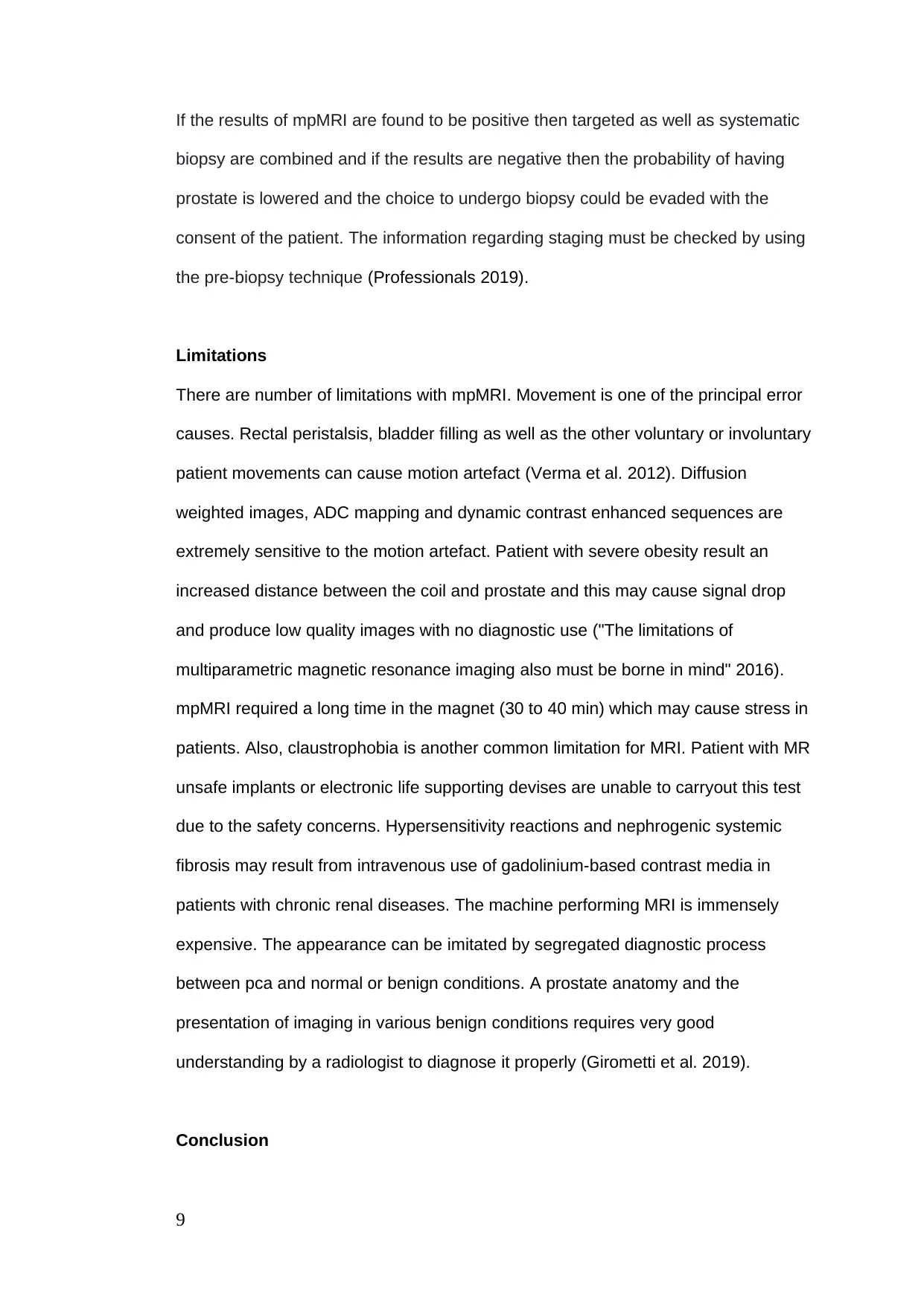
If the results of mpMRI are found to be positive then targeted as well as systematic
biopsy are combined and if the results are negative then the probability of having
prostate is lowered and the choice to undergo biopsy could be evaded with the
consent of the patient. The information regarding staging must be checked by using
the pre-biopsy technique (Professionals 2019).
Limitations
There are number of limitations with mpMRI. Movement is one of the principal error
causes. Rectal peristalsis, bladder filling as well as the other voluntary or involuntary
patient movements can cause motion artefact (Verma et al. 2012). Diffusion
weighted images, ADC mapping and dynamic contrast enhanced sequences are
extremely sensitive to the motion artefact. Patient with severe obesity result an
increased distance between the coil and prostate and this may cause signal drop
and produce low quality images with no diagnostic use ("The limitations of
multiparametric magnetic resonance imaging also must be borne in mind" 2016).
mpMRI required a long time in the magnet (30 to 40 min) which may cause stress in
patients. Also, claustrophobia is another common limitation for MRI. Patient with MR
unsafe implants or electronic life supporting devises are unable to carryout this test
due to the safety concerns. Hypersensitivity reactions and nephrogenic systemic
fibrosis may result from intravenous use of gadolinium-based contrast media in
patients with chronic renal diseases. The machine performing MRI is immensely
expensive. The appearance can be imitated by segregated diagnostic process
between pca and normal or benign conditions. A prostate anatomy and the
presentation of imaging in various benign conditions requires very good
understanding by a radiologist to diagnose it properly (Girometti et al. 2019).
Conclusion
9
biopsy are combined and if the results are negative then the probability of having
prostate is lowered and the choice to undergo biopsy could be evaded with the
consent of the patient. The information regarding staging must be checked by using
the pre-biopsy technique (Professionals 2019).
Limitations
There are number of limitations with mpMRI. Movement is one of the principal error
causes. Rectal peristalsis, bladder filling as well as the other voluntary or involuntary
patient movements can cause motion artefact (Verma et al. 2012). Diffusion
weighted images, ADC mapping and dynamic contrast enhanced sequences are
extremely sensitive to the motion artefact. Patient with severe obesity result an
increased distance between the coil and prostate and this may cause signal drop
and produce low quality images with no diagnostic use ("The limitations of
multiparametric magnetic resonance imaging also must be borne in mind" 2016).
mpMRI required a long time in the magnet (30 to 40 min) which may cause stress in
patients. Also, claustrophobia is another common limitation for MRI. Patient with MR
unsafe implants or electronic life supporting devises are unable to carryout this test
due to the safety concerns. Hypersensitivity reactions and nephrogenic systemic
fibrosis may result from intravenous use of gadolinium-based contrast media in
patients with chronic renal diseases. The machine performing MRI is immensely
expensive. The appearance can be imitated by segregated diagnostic process
between pca and normal or benign conditions. A prostate anatomy and the
presentation of imaging in various benign conditions requires very good
understanding by a radiologist to diagnose it properly (Girometti et al. 2019).
Conclusion
9
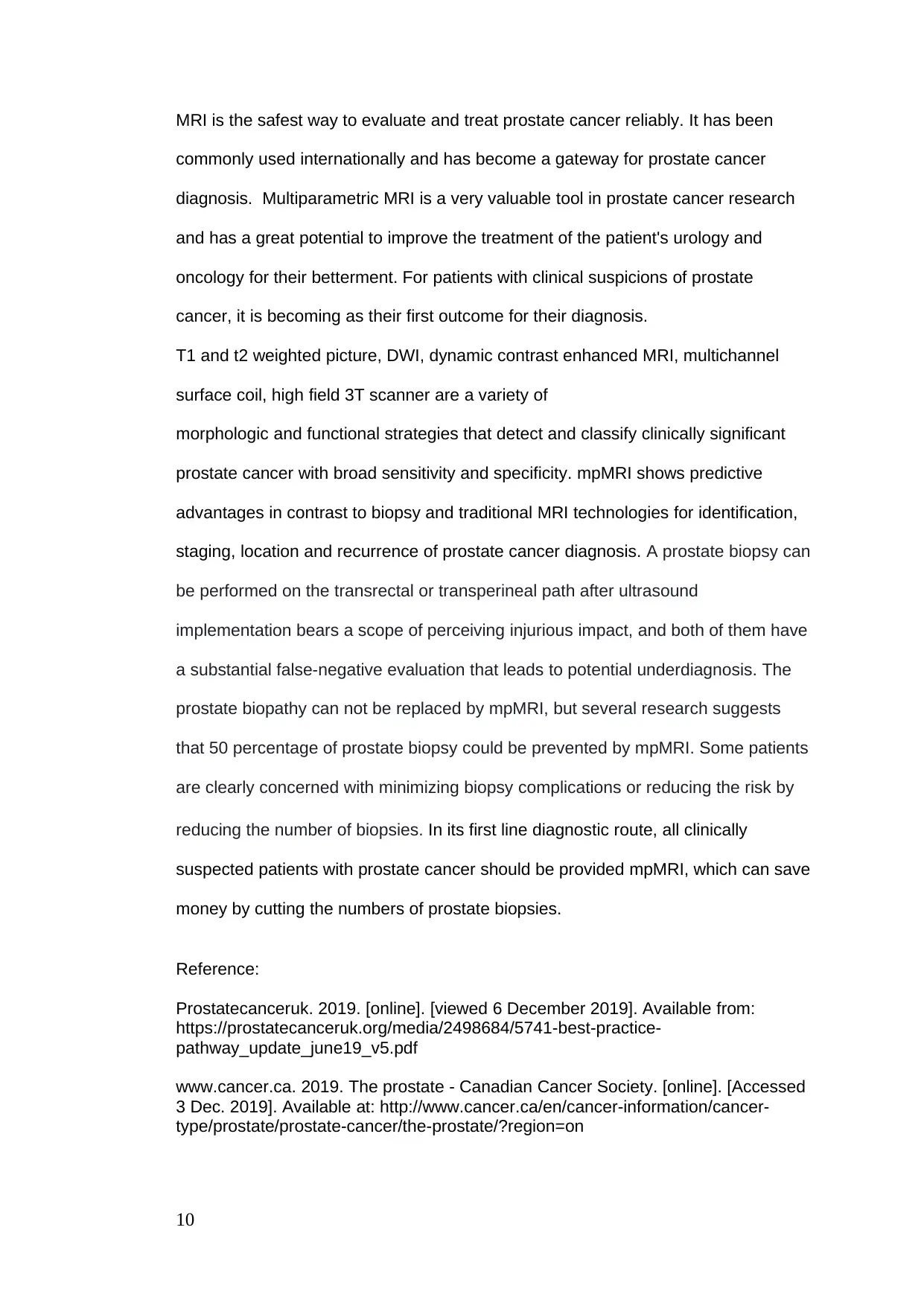
MRI is the safest way to evaluate and treat prostate cancer reliably. It has been
commonly used internationally and has become a gateway for prostate cancer
diagnosis. Multiparametric MRI is a very valuable tool in prostate cancer research
and has a great potential to improve the treatment of the patient's urology and
oncology for their betterment. For patients with clinical suspicions of prostate
cancer, it is becoming as their first outcome for their diagnosis.
T1 and t2 weighted picture, DWI, dynamic contrast enhanced MRI, multichannel
surface coil, high field 3T scanner are a variety of
morphologic and functional strategies that detect and classify clinically significant
prostate cancer with broad sensitivity and specificity. mpMRI shows predictive
advantages in contrast to biopsy and traditional MRI technologies for identification,
staging, location and recurrence of prostate cancer diagnosis. A prostate biopsy can
be performed on the transrectal or transperineal path after ultrasound
implementation bears a scope of perceiving injurious impact, and both of them have
a substantial false-negative evaluation that leads to potential underdiagnosis. The
prostate biopathy can not be replaced by mpMRI, but several research suggests
that 50 percentage of prostate biopsy could be prevented by mpMRI. Some patients
are clearly concerned with minimizing biopsy complications or reducing the risk by
reducing the number of biopsies. In its first line diagnostic route, all clinically
suspected patients with prostate cancer should be provided mpMRI, which can save
money by cutting the numbers of prostate biopsies.
Reference:
Prostatecanceruk. 2019. [online]. [viewed 6 December 2019]. Available from:
https://prostatecanceruk.org/media/2498684/5741-best-practice-
pathway_update_june19_v5.pdf
www.cancer.ca. 2019. The prostate - Canadian Cancer Society. [online]. [Accessed
3 Dec. 2019]. Available at: http://www.cancer.ca/en/cancer-information/cancer-
type/prostate/prostate-cancer/the-prostate/?region=on
10
commonly used internationally and has become a gateway for prostate cancer
diagnosis. Multiparametric MRI is a very valuable tool in prostate cancer research
and has a great potential to improve the treatment of the patient's urology and
oncology for their betterment. For patients with clinical suspicions of prostate
cancer, it is becoming as their first outcome for their diagnosis.
T1 and t2 weighted picture, DWI, dynamic contrast enhanced MRI, multichannel
surface coil, high field 3T scanner are a variety of
morphologic and functional strategies that detect and classify clinically significant
prostate cancer with broad sensitivity and specificity. mpMRI shows predictive
advantages in contrast to biopsy and traditional MRI technologies for identification,
staging, location and recurrence of prostate cancer diagnosis. A prostate biopsy can
be performed on the transrectal or transperineal path after ultrasound
implementation bears a scope of perceiving injurious impact, and both of them have
a substantial false-negative evaluation that leads to potential underdiagnosis. The
prostate biopathy can not be replaced by mpMRI, but several research suggests
that 50 percentage of prostate biopsy could be prevented by mpMRI. Some patients
are clearly concerned with minimizing biopsy complications or reducing the risk by
reducing the number of biopsies. In its first line diagnostic route, all clinically
suspected patients with prostate cancer should be provided mpMRI, which can save
money by cutting the numbers of prostate biopsies.
Reference:
Prostatecanceruk. 2019. [online]. [viewed 6 December 2019]. Available from:
https://prostatecanceruk.org/media/2498684/5741-best-practice-
pathway_update_june19_v5.pdf
www.cancer.ca. 2019. The prostate - Canadian Cancer Society. [online]. [Accessed
3 Dec. 2019]. Available at: http://www.cancer.ca/en/cancer-information/cancer-
type/prostate/prostate-cancer/the-prostate/?region=on
10
Secure Best Marks with AI Grader
Need help grading? Try our AI Grader for instant feedback on your assignments.

"Canadian Cancer Society". 2019. [viewed 6 December 2019]. Available from:
http://www.cancer.ca/en/cancer-information/cancer-type/prostate/prostate-cancer/
the-prostate
MURPHY, G., HAIDER, M., GHAI, S. and SREEHARSHA, B., 2013. "The
Expanding Role of MRI in Prostate Cancer". American Journal of Roentgenology.
vol. , 201, no. , 6, pp. 1229-1238.
"Components & Functions". 2019. [viewed 6 December 2019]. Available from:
https://snc2dmri.weebly.com/components--functions.html
"Prostate Imaging – Reporting and Data System". 2019. [viewed 6 December 2019].
Available from: https://www.acr.org/-/media/ACR/Files/RADS/Pi-RADS/PIRADS-V2-
1.pdf?la=en
COLD et al. 2019. "The Prostate (Human Anatomy): Prostate Picture, Definition,
Function, Conditions, Tests, and Treatments" [online]. [viewed 6 December 2019].
Available from: https://www.webmd.com/men/picture-of-the-prostate#1
STAROBINETS, O., KORN, N., IQBAL, S., NOWOROLSKI, S., ZAGORIA, R.,
KURHANEWICZ, J. and WESTPHALEN, A., 2015. "Practical aspects of prostate
MRI: hardware and software considerations, protocols, and patient
preparation". Abdominal Radiology. vol. , 41, no. , 5, pp. 817-830.
XIAO, Y., PAUDEL, R., LIU, J., MA, C., ZHANG, Z. and ZHOU, S., 2016. "MRI
contrast agents: Classification and application (Review)". International Journal of
Molecular Medicine. vol. , 38, no. , 5, pp. 1319-1326.
BOESEN, L., NØRGAARD, N., LØGAGER, V., BALSLEV, I., BISBJERG, R.,
THESTRUP, K., WINTHER, M., JAKOBSEN, H. and THOMSEN, H., 2018.
"Assessment of the Diagnostic Accuracy of Biparametric Magnetic Resonance
Imaging for Prostate Cancer in Biopsy-Naive Men". JAMA Network Open. vol. , 1,
no. , 2, pp. 1-12.
PROFESSIONALS, S., 2019. "EAU Guidelines: Prostate Cancer | Uroweb" [online].
[viewed 22 December 2019]. Available from: https://uroweb.org/guideline/prostate-
cancer/#5
GIROMETTI, R., CERESER, L., BONATO, F. and ZUIANI, C., 2019. "Evolution of
prostate MRI: from multiparametric standard to less-is-better and different-is better
strategies". European Radiology Experimental. vol. , 3, no. , 1.
Rosenkrantz, A.,2017. MRI of the prostate. Thieme.
SPOUGE, A. and POPE, T., 2017. Practical MRI. New York: Informa Healthcare.
Westbrook, C. and Talbot, J., 2019. MRI in practice. 5th ed. pp.25-26.
WU, L., XU, J., YE, Y., LU, Q. and HU, J., 2012. "The Clinical Value of Diffusion-
Weighted Imaging in Combination with T2-Weighted Imaging in Diagnosing Prostate
Carcinoma: A Systematic Review and Meta-Analysis". American Journal of
Roentgenology. vol. , 199, no. , 1, pp. 103-110.
11
http://www.cancer.ca/en/cancer-information/cancer-type/prostate/prostate-cancer/
the-prostate
MURPHY, G., HAIDER, M., GHAI, S. and SREEHARSHA, B., 2013. "The
Expanding Role of MRI in Prostate Cancer". American Journal of Roentgenology.
vol. , 201, no. , 6, pp. 1229-1238.
"Components & Functions". 2019. [viewed 6 December 2019]. Available from:
https://snc2dmri.weebly.com/components--functions.html
"Prostate Imaging – Reporting and Data System". 2019. [viewed 6 December 2019].
Available from: https://www.acr.org/-/media/ACR/Files/RADS/Pi-RADS/PIRADS-V2-
1.pdf?la=en
COLD et al. 2019. "The Prostate (Human Anatomy): Prostate Picture, Definition,
Function, Conditions, Tests, and Treatments" [online]. [viewed 6 December 2019].
Available from: https://www.webmd.com/men/picture-of-the-prostate#1
STAROBINETS, O., KORN, N., IQBAL, S., NOWOROLSKI, S., ZAGORIA, R.,
KURHANEWICZ, J. and WESTPHALEN, A., 2015. "Practical aspects of prostate
MRI: hardware and software considerations, protocols, and patient
preparation". Abdominal Radiology. vol. , 41, no. , 5, pp. 817-830.
XIAO, Y., PAUDEL, R., LIU, J., MA, C., ZHANG, Z. and ZHOU, S., 2016. "MRI
contrast agents: Classification and application (Review)". International Journal of
Molecular Medicine. vol. , 38, no. , 5, pp. 1319-1326.
BOESEN, L., NØRGAARD, N., LØGAGER, V., BALSLEV, I., BISBJERG, R.,
THESTRUP, K., WINTHER, M., JAKOBSEN, H. and THOMSEN, H., 2018.
"Assessment of the Diagnostic Accuracy of Biparametric Magnetic Resonance
Imaging for Prostate Cancer in Biopsy-Naive Men". JAMA Network Open. vol. , 1,
no. , 2, pp. 1-12.
PROFESSIONALS, S., 2019. "EAU Guidelines: Prostate Cancer | Uroweb" [online].
[viewed 22 December 2019]. Available from: https://uroweb.org/guideline/prostate-
cancer/#5
GIROMETTI, R., CERESER, L., BONATO, F. and ZUIANI, C., 2019. "Evolution of
prostate MRI: from multiparametric standard to less-is-better and different-is better
strategies". European Radiology Experimental. vol. , 3, no. , 1.
Rosenkrantz, A.,2017. MRI of the prostate. Thieme.
SPOUGE, A. and POPE, T., 2017. Practical MRI. New York: Informa Healthcare.
Westbrook, C. and Talbot, J., 2019. MRI in practice. 5th ed. pp.25-26.
WU, L., XU, J., YE, Y., LU, Q. and HU, J., 2012. "The Clinical Value of Diffusion-
Weighted Imaging in Combination with T2-Weighted Imaging in Diagnosing Prostate
Carcinoma: A Systematic Review and Meta-Analysis". American Journal of
Roentgenology. vol. , 199, no. , 1, pp. 103-110.
11

IBRAHIM, D., 2019. "Normal prostate (MRI) | Radiology Case | Radiopaedia.org"
[online]. [viewed 14 December 2019]. Available from:
https://radiopaedia.org/cases/normal-prostate-mri-1
VERMA, S., TURKBEY, B., MURADYAN, N., RAJESH, A., CORNUD, F., HAIDER,
M., CHOYKE, P. and HARISINGHANI, M., 2012. "Overview of Dynamic Contrast-
Enhanced MRI in Prostate Cancer Diagnosis and Management". American Journal
of Roentgenology. vol. , 198, no. , 6, pp. 1277-1288.
VAN DER LEEST, M., CORNEL, E., ISRAËL, B., HENDRIKS, R., PADHANI, A.,
HOOGENBOOM, M., ZAMECNIK, P., BAKKER, D., SETIASTI, A., VELTMAN, J.,
VAN DEN HOUT, H., VAN DER LELIJ, H., VAN OORT, I., KLAVER, S.,
DEBRUYNE, F., SEDELAAR, M., HANNINK, G., ROVERS, M., HULSBERGEN-
VAN DE KAA, C. and BARENTSZ, J., 2019. "Head-to-head Comparison of
Transrectal Ultrasound-guided Prostate Biopsy Versus Multiparametric Prostate
Resonance Imaging with Subsequent Magnetic Resonance-guided Biopsy in
Biopsy-naïve Men with Elevated Prostate-specific Antigen: A Large Prospective
Multicenter Clinical Study". European Urology. vol. , 75, no. , 4, pp. 570-578.
KAPOOR, J., LAMB, A. and MURPHY, D., 2017. "Re: Diagnostic Accuracy of Multi-
parametric MRI and TRUS Biopsy in Prostate Cancer (PROMIS): A Paired
Validating Confirmatory Study". European Urology. vol. , 72, no. , 1, p. 151.
"NICE Guidance - Prostate cancer: diagnosis and management". 2019. vol. , 124,
no. , 1, pp. 9-26.
Weinreb, J. , 2019. Prostate Imaging – Reporting and Data System. [online].
[Accessed 3 Dec. 2019]. Acr.org. Available at:
https://www.acr.org/-/media/ACR/Files/RADS/Pi-RADS/PIRADS-V2.pdf
Acr.org. , 2019. [online]. [viewed 23 December 2019]. Available from:
https://www.acr.org/-/media/ACR/Files/RADS/Pi-RADS/PIRADS-V2-1.pdf?la=en
Vilanova, J., Catalá, V., Algaba, F. and Laucirica Gari, O. 2018. Atlas of
multiparametric prostate MRI with PI-RADS approach and anatomic-MRI-
pathological correlation. Cham: Springer International Publishing, pp.1-20.
Stark, D. and Bradley, W. (1999). Magnetic resonance imaging. 3rd ed. St. Louis:
Mosby, pp.617-632.
"The limitations of multiparametric magnetic resonance imaging also must be borne
in mind". 2016. vol. , 69, no. , 1, pp. 22-23.
LE BIHAN, D., 2013. "Apparent Diffusion Coefficient and Beyond: What Diffusion
MR Imaging Can Tell Us about Tissue Structure". Radiology. vol. , 268, no. , 2, pp.
318-322.
PESAPANE, F., VILLEIRS, G. and DE VISSCHERE, P., 2017. "The T1 Hemorrhage
Exclusion Sign in the Detection of Prostate Cancer at MRI". Journal of the Belgian
Society of Radiology. vol. , 101, no. , 1.
12
[online]. [viewed 14 December 2019]. Available from:
https://radiopaedia.org/cases/normal-prostate-mri-1
VERMA, S., TURKBEY, B., MURADYAN, N., RAJESH, A., CORNUD, F., HAIDER,
M., CHOYKE, P. and HARISINGHANI, M., 2012. "Overview of Dynamic Contrast-
Enhanced MRI in Prostate Cancer Diagnosis and Management". American Journal
of Roentgenology. vol. , 198, no. , 6, pp. 1277-1288.
VAN DER LEEST, M., CORNEL, E., ISRAËL, B., HENDRIKS, R., PADHANI, A.,
HOOGENBOOM, M., ZAMECNIK, P., BAKKER, D., SETIASTI, A., VELTMAN, J.,
VAN DEN HOUT, H., VAN DER LELIJ, H., VAN OORT, I., KLAVER, S.,
DEBRUYNE, F., SEDELAAR, M., HANNINK, G., ROVERS, M., HULSBERGEN-
VAN DE KAA, C. and BARENTSZ, J., 2019. "Head-to-head Comparison of
Transrectal Ultrasound-guided Prostate Biopsy Versus Multiparametric Prostate
Resonance Imaging with Subsequent Magnetic Resonance-guided Biopsy in
Biopsy-naïve Men with Elevated Prostate-specific Antigen: A Large Prospective
Multicenter Clinical Study". European Urology. vol. , 75, no. , 4, pp. 570-578.
KAPOOR, J., LAMB, A. and MURPHY, D., 2017. "Re: Diagnostic Accuracy of Multi-
parametric MRI and TRUS Biopsy in Prostate Cancer (PROMIS): A Paired
Validating Confirmatory Study". European Urology. vol. , 72, no. , 1, p. 151.
"NICE Guidance - Prostate cancer: diagnosis and management". 2019. vol. , 124,
no. , 1, pp. 9-26.
Weinreb, J. , 2019. Prostate Imaging – Reporting and Data System. [online].
[Accessed 3 Dec. 2019]. Acr.org. Available at:
https://www.acr.org/-/media/ACR/Files/RADS/Pi-RADS/PIRADS-V2.pdf
Acr.org. , 2019. [online]. [viewed 23 December 2019]. Available from:
https://www.acr.org/-/media/ACR/Files/RADS/Pi-RADS/PIRADS-V2-1.pdf?la=en
Vilanova, J., Catalá, V., Algaba, F. and Laucirica Gari, O. 2018. Atlas of
multiparametric prostate MRI with PI-RADS approach and anatomic-MRI-
pathological correlation. Cham: Springer International Publishing, pp.1-20.
Stark, D. and Bradley, W. (1999). Magnetic resonance imaging. 3rd ed. St. Louis:
Mosby, pp.617-632.
"The limitations of multiparametric magnetic resonance imaging also must be borne
in mind". 2016. vol. , 69, no. , 1, pp. 22-23.
LE BIHAN, D., 2013. "Apparent Diffusion Coefficient and Beyond: What Diffusion
MR Imaging Can Tell Us about Tissue Structure". Radiology. vol. , 268, no. , 2, pp.
318-322.
PESAPANE, F., VILLEIRS, G. and DE VISSCHERE, P., 2017. "The T1 Hemorrhage
Exclusion Sign in the Detection of Prostate Cancer at MRI". Journal of the Belgian
Society of Radiology. vol. , 101, no. , 1.
12

J. H. JANG, I., 2019. "Variable imaging findings of prostate cancer: Focus on MR
and PET/CT imaging" [online]. [viewed 25 December 2019]. Available from:
https://posterng.netkey.at/esr/viewing/index.php?
module=viewing_poster&task=imagegallery&pi=28842&backURL=index.php
%3Fmodule%3Dviewing_poster%26task%3Dviewsection%26pi%3D28842%26ti
%3D85470&mediafile_id=213365&201108180940.jpg
13
and PET/CT imaging" [online]. [viewed 25 December 2019]. Available from:
https://posterng.netkey.at/esr/viewing/index.php?
module=viewing_poster&task=imagegallery&pi=28842&backURL=index.php
%3Fmodule%3Dviewing_poster%26task%3Dviewsection%26pi%3D28842%26ti
%3D85470&mediafile_id=213365&201108180940.jpg
13
1 out of 13
Your All-in-One AI-Powered Toolkit for Academic Success.
+13062052269
info@desklib.com
Available 24*7 on WhatsApp / Email
![[object Object]](/_next/static/media/star-bottom.7253800d.svg)
Unlock your academic potential
© 2024 | Zucol Services PVT LTD | All rights reserved.